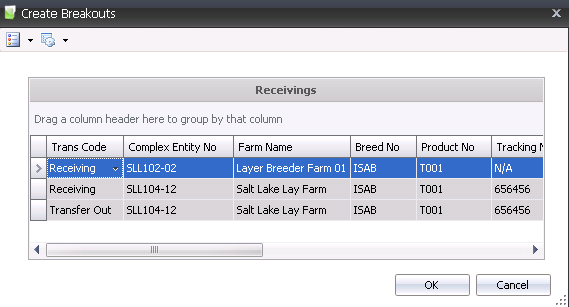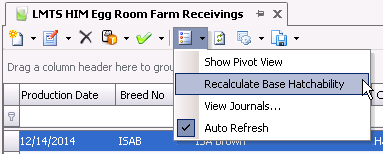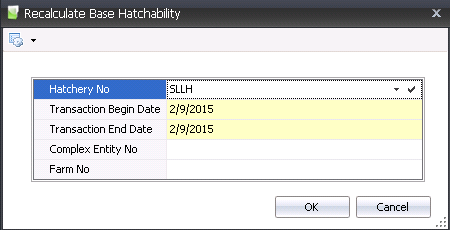Farm Receivings

The Egg Room Farm Receiving transaction records the egg being received
at the hatchery from the entity. If the farm maintains an egg room process,
there is an option to transfer the eggs from the farm egg room to the
hatchery egg room.
The Egg Room Mode switch must be selected before creating an egg room
farm receiving transaction. The switch is located in: Admin>System>Registry>Poultry Registry>Poultry>PMTS>Layer
Breeder>Period End>BIM Farm Egg Room Mode. Select Direct Hatchery Deliveries.
Before creating a Farm Receiving transaction, the following must be
created:
The following procedures are outlined in the Farm Receiving document:
Create
a Farm Receiving Transaction
- In LMTS>HIM>Transactions>Eggs>Egg
Room, select Farm Receivings.
- In the Egg Room
Farm Receivings main index,
click
 to create a new farm receiving transaction.
to create a new farm receiving transaction.
- In the New Record dialog box, from Hatchery
No, select the required hatchery.
- Enter the Date
of the transaction and then click 'OK'.
- In the Farm Receivings screen, click
 to add a new receiving
line. This automatically defaults to a Receiving transaction. Other
options in the
to add a new receiving
line. This automatically defaults to a Receiving transaction. Other
options in the  drop-down menu are:
drop-down menu are:
- Debit
Adjustment (To Flock) - Debit adjusts the quantity to the
entity only, but does not affect egg inventory.
- Credit
Adjustment (To Flock) - Credit adjusts the quantity to
the entity only, but does not affect egg inventory.
- Negative
Variance Adjustment (To Inventory) - Credit adjusts the
egg inventory.
- Positive
Variance Adjustment (To Inventory) - Debit adjusts the
egg inventory.
- Beginning
Inventory Entity - Enters beginning inventory balances,
and is only used at startup for the hatchery.
- WOL displays
the number of weeks in lay that the entity produced eggs.
- Egg Trans Code
indicates the type of egg transaction, and will default to 'Received'
when a new receiving transaction is recorded.
- In the Tracking
No field, enter a unique reference number to identify the receiving
transaction. Tracking No is a required field.
- From the Complex
Entity No drop-down menu, select the entity that produced the
eggs.
- Farm Name
will default in from Complex Entity No and displays the name of the
farm that produced the eggs.
- From Product
No, select the egg product that will be received/transferred.
- Product Name
will default from Product No and displays a description of the product.
- Breed No
is a derived field based on the selected entity, and is used to identify
the breed of the eggs.
- Breed Name
displays a description of the breed code.
- Generation is a derived field
based on the selected entity, and is used to identify the generation
of the eggs. Available options are: GGP, GP, Parent or Pedigree.
- Production Date
indicates the date that the eggs were produced, to determine egg age.
- Received Date
indicates the date the eggs were received at the hatchery.
Egg Age
is a derived field based on the received date less the production
date.
Flock Age
is a derived field based on the selected entity and the production
date.
Enter the number of Units
being received/transferred.
Eggs
displays the number of eggs received. This is a calculated field based
on the number of units received and the eggs per unit received.
Units Per
is a derived field that defines the number of eggs per unit received.
Enter the total Price
for the eggs being received.
Outside Temperature
is an optional field used to enter the recorded external temperature
of the farm. Outside Temperature can be entered in either oF or oC.
Vehicle Temperature
is an optional field used to record the trailer temperature and can
be entered in either oF or oC.
Unit Price
is an automatically calculated field that displays the per unit price
of the eggs. Unit Price = Price/Units
Ref No
is an optional field to enter a unique reference number to identify
the transaction. This can either be entered manually or automatically-generated.
Load No
is an optional field to enter the load number of the delivery.
In the Egg
Weight field, enter the weight per egg, or a single average
weight of all the eggs being received.

Uniformity
M is an optional field to enter the consistency of the weight
of the male birds.
Egg CV Uniformity
is an optional field to enter the coefficient variable
for the weight samples. A CV uniformity column is available for each
sex.
From Vehicle
No, select the vehicle that will be used to transport the eggs.
Vehicles must be set up prior to use in: Admin>Business>General>Definitions>Vehicles.
Vehicle Name
will default from Vehicle No and displays a description of the vehicle.
From Driver
No, select the driver who will be transporting the eggs. Drivers
must be set up prior to use in: Admin>Business>General>Definitions>Drivers.
Driver Name
will default from Driver No and displays the name of the driver.
- From Buggy No,
select the buggy used if the eggs are loaded directly onto a buggy.
- Buggy Name
will default from Buggy No and displays the name of the buggy, if
applicable.
- Base Hatch
defines the hatchability of the eggs and defaults from the standard
table assigned to the entity.
- Projected Hatch
adjusts the based hatch percent on the egg age if an egg age decline
table is used as well as recent hatch transactions.
- Projected Chicks
is a calculated field for the estimated number of chicks, based on
the eggs being received multiplied by the projected hatch.
- In the Notes
field, enter any additional information relating to the farm receiving
transaction.
- Sales SKU No
identifies the sales SKU number of the product, if applicable.
- Sales SKU Name
displays the sales SKU name.
- Package No
displays the package number, if the product was packaged.
- Select the Final
Egg Pickup flag if this is the last or final egg pickup of
the entity. If the flag is selected, no more eggs will be received
from that entity.
- Selecting the Void
flag will cancel the receiving transaction.

Additional Options
There are two Options menus that contain additional options related
to the Machine Transfers transaction:
Create a Breakout
In the Egg Room Farm Receiving transaction screen, the Options menu
can be used to create a breakout transaction.
- In the Egg Room Farm Receivings transaction screen,
click the Options
 button and select Create Breakout.
button and select Create Breakout.

- The Create Breakouts dialog box will appear with
all available receiving transactions.

- Select the required entity line and click the
OK button. A Pre Incubation Breakout transaction will be created.

Recalculate Base
Hatchability
- In the Egg Room Farm Receivings main index, click
the Options
 button and
select Recalculate Base Hatchability.
button and
select Recalculate Base Hatchability.

- The Recalculate Base Hatchability dialog box will
appear.

- From Hatchery
No, select the hatchery where the base hatchability
will be recalculated.
- Transaction Begin
Date is used to enter the beginning date for the transaction
date range to determine what records are to be calculated.
- Transaction End
Date is used to enter the ending date for the transaction date
range to determine what records are to be calculated.
- Complex Entity
No is an optional field that can be used to select the parent
flocks to be recalculated.
- Farm No
is an optional field to select the parent flock farms to be recalculated.
- Click the `OK` button and the hatchability will
be recalculated.
Post
a Farm Receiving Transaction
Once the farm receiving transaction is saved and closed, the transaction
can be posted. The posting process locks the transaction to prevent edits,
and will add the product to egg room inventory and pass the statistical
data back to the entity. Journals will be created if there is an internal
price set up for the product. This amount will be reversed at period end
when the actual amount is calculated. If there is no internal price, there
are no journals.
- In the Farm Receivings main index, select the
required transaction, rick-click and select 'Post.' Alternatively,
click the green check mark
 in the top menu bar and select 'Post'.
in the top menu bar and select 'Post'.
- To un-post a farm receiving transaction, select
the required transaction and right-click to select 'Unpost'. This
process will set the transaction status to 'Reversed' status, which
allows the transaction to be edited.
Journal
Transaction
The posting process creates the journal
transaction if there is an internal price set up for the product. In these
cases, the journal transaction is created to debit the egg room inventory
of the hatchery and credit the breeder that transferred out the farm eggs.


 to create a new farm receiving transaction.
to create a new farm receiving transaction. to add a new receiving
line. This automatically defaults to a Receiving transaction. Other
options in the
to add a new receiving
line. This automatically defaults to a Receiving transaction. Other
options in the  drop-down menu are:
drop-down menu are:

 button and select Create Breakout.
button and select Create Breakout.


 button and
select Recalculate Base Hatchability.
button and
select Recalculate Base Hatchability.

 in the top menu bar and select 'Post'.
in the top menu bar and select 'Post'.